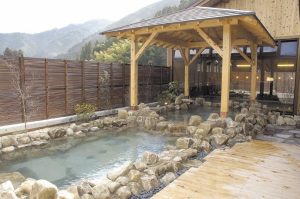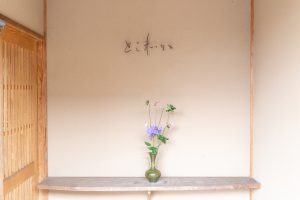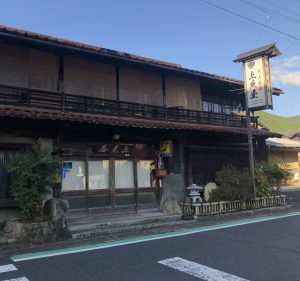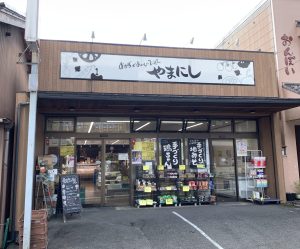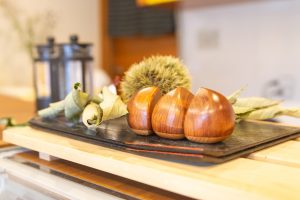明治40(1907)年創業の南陽軒は、下付知のあたりで和菓子屋を始めました。南陽軒という名前は、付知の南の方にあったということに由来するそう。創業当時は皮が黒砂糖、中がこし餡の黒饅頭を中心に作っており、これは五厘饅頭と呼ばれていました。
現在の場所に移転をしたのは2代目の時代です。元々は街道筋で栄えた大きな旅館がありましたが、その隣の馬小屋の土地を分けてもらい、下付知からお店を移転させました。その後昭和40年代に旅館の跡地にお店を建て直し、現在の姿となっています。
2代目は、東京世田谷の和菓子店で本格的に修行をし、パンやケーキの技術を身につけました。東京では毎日のように喫茶店に通い、日記帳にロールケーキやショートケーキのイラストをスケッチしていたそうです。またカメラや機械いじりもお好きで、自ら図面を引き、機械を作ってしまうほどであったとか。
2代目が付知に戻り南陽軒を継いでからまもなくして、戦争が始まりました。鉄の供出によって製菓用の鍋や釜を失い、終戦時には鍋一つしか残っていなかったと言います。2代目はその鍋で、地物のサツマイモの芋飴を作りました。甘いものや砂糖がなかった当時は、芋飴を買い求める人の行列が出来たそう。また戦後は学校給食のパンも始め、オート三輪やトラックで学校への配達を行いました。
そんな歴史ある南陽軒の看板商品は、栗きんとんと栗柿です。栗きんとんは昭和57(1982)年頃、栗柿はその10年ほど後に、いずれも3代目が製造を始めました。他のお店との違いは、栗きんとんと栗柿を通年で販売をしていること。栗は毎年20tほど、柿は農園に直接買い付けに出向くなどして、毎年10tほどを仕入れています。
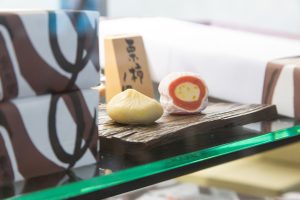
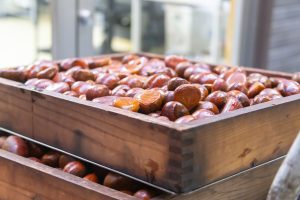
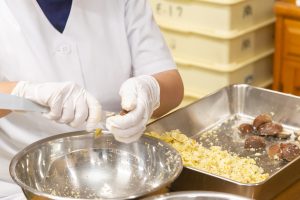
今回お話を伺った4代目の小南正信専務は、いち早く通信販売を始め、全国に南陽軒のお菓子を届けています。また、栗きんとん生クリーム大福という新たな商品も開発しました。当初は和風のモンブランを作ろうと考えたそうですが、どうしても栗きんとんの上品な風味が生クリームに負けてしまう。そこで栗きんとんと生クリームを大福で包みこむことで、口の中でモンブランのような味わいを生み出す商品を生み出しました。
「付知は水が綺麗なので。製餡するときに、水を大量に使うんですよ。皮をむいて、中の小豆を煮出すのにすごく水を使うんですよ。お菓子作りにも、水が綺麗っていうのは向いていますよね、土地としては。」(小南正信さん)
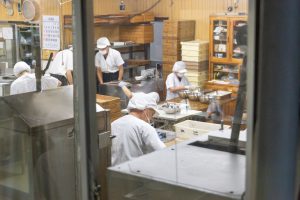
付知が誇る綺麗な水を使い、手作りにこだわった南陽軒のお菓子は、店頭だけでなく通信販売でもお買い求めいただけます。遠方にお住まいの方も、付知の銘菓をぜひご賞味ください。
Nanyoken
Founded in 1907(Meiji 40), Nanyoken started a Japanese sweets shop in the Shimotsukechi area. The name “Nanyoken” comes from the fact that it was located in the southern part of Tsukechi. At the time of its establishment, it mainly made black buns with brown sugar on the skin and strained bean paste inside, which was called gorin-manju.
It was during the second generation that the shop moved to its current location. Originally, there was a large inn that prospered along the roadside. Nanyoken moved from Shimotsukechi to a parcel of divided stable land next to the inn. Later, in the 1960s, the store was rebuilt on the former site of the inn, where it stands today.
The second owner mastered the art of making bread and cakes by training at a Japanese confectionery shop in Setagaya, Tokyo. In Tokyo, he went to a coffee shop almost every day and sketched illustrations of roll cakes and shortcakes in his diary. He also liked cameras and tinkering with machines, so much so that he even drew blueprints and built machines himself.
Shortly after the second owner returned to Tsukechi and took over Nanyoken, the war began. It is said that by the end of the war, there was only one pot left after the end of the war. The second owner used that pot to make local sweet potato candy. In those days, when sweets and sugar were scarce, people would line up to buy sweet potato candy. After the war, they started making bread for school lunches and delivered it to schools by three-wheelers or trucks.
The signature products of Nanyoken, which has such a long history, are “kurikinton”(Japanese sweets using chestnuts) and “kurigaki”(Japanese sweets with kuri kinton wrapped in dried persimmon). The third generation of Nanyoken’s family began making kurikinton around 1982 and kurigaki about 10 years later. The difference from other shops is that they sell kurikinton and kurigaki all year round. About 20 tons of chestnuts are purchased every year, and about 10 tons of persimmons are purchased by going directly to the farm.
Masanobu Kominami, the 4th generation managing director who we interviewed for this time, was one of the first to start mail-order sales, delivering Nanyoken sweets all over the country. He also developed a new product called “kurikinton fresh cream daifuku”. At first, he thought of making a Japanese-style Mont Blanc, but the elegant flavor of kurikinton was inevitably lost to fresh cream. Therefore, by wrapping kurikinton and fresh cream in daifuku, they created a product that tastes like Mont Blanc in the mouth.
“Because the water in Tsukechi is so clean, we use a lot of water to make the bean paste. It takes a lot of water to peel the skin and boil the azuki beans inside. This land with its clean water is ideal for making sweets.” (Mr. Masanobu Kominami)
Nanyoken’s sweets are hand-made using the clean water that Tsukechi is proud of, and can be purchased not only at stores but also through mail order. Even if you live far away, please enjoy Tsukechi’s famous sweets.

